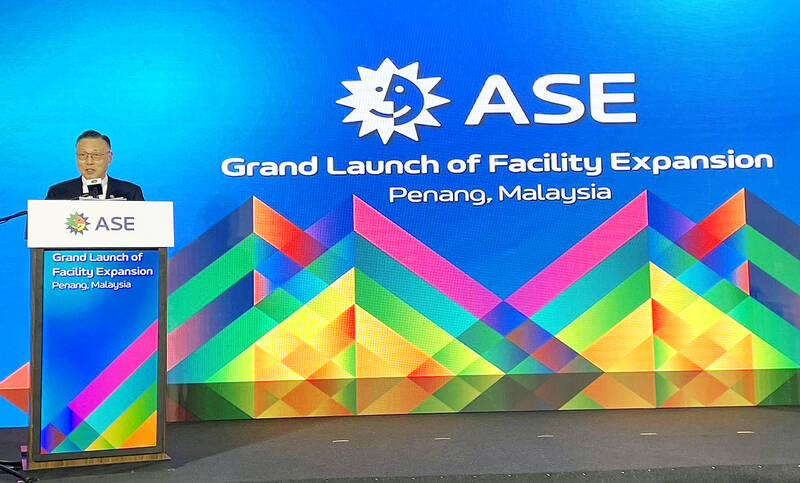ASE Technology Holding Co (日月光投控), the world’s largest provider of outsourced semiconductor assembly and test (OSAT) services, yesterday launched a new advanced manufacturing facility in Penang, Malaysia, aiming to meet growing demand for emerging technologies such as generative artificial intelligence (AI) applications.
The US$300 million facility is a critical step in expanding ASE’s global footprint, offering an alternative for customers from the US, Europe, Japan, South Korea and China to assemble and test chips outside of Taiwan amid efforts to diversify supply chains.
The plant, the company’s fifth in Malaysia, is part of a strategic expansion plan that would more than triple the floor space of ASE Malaysia to approximately 315,870m2, from 92.903m2, it said in a statement.

Photo: CNA
“Southeast Asia is increasingly becoming an important base for semiconductors, given its growing digital economy propelling demand for advanced chips and its shift toward design and chip manufacturing in the past few years,” ASE chief executive officer Tien Wu (吳田玉) said in the statement.
“With Malaysia solidifying its position as a regional semiconductor hub, we see our expanded facility playing an even greater role across the global semiconductor value chain and contributing to the country’s economic growth,” Wu said.
“ASE remains committed to being a driving force for the development of the local and regional semiconductor industry, while continuing to meet and exceed the needs and expectations of our customers,” he said.
A majority of ASE Malaysia’s capacity is used to make image sensors and power management chips for vehicles and industrial devices, while the new plant would build new image sensors for industrial or humanoid robots, the company said.
At home, ASE also plans to make new investments totaling US$200 million to build its first large-size panel-level packaging facility in Kaohsiung, Wu said.
The company is to start a pilot run of the production line in the third quarter this year, he said.
ASE’s capacity expansion at home and overseas is based on its positive demand forecast, it said.
ASE on Monday gave a favorable forecast for its business, riding on the global semiconductor industry’s growth trajectory.
By 2032, total semiconductor revenue is to reach US$1 trillion, with OSAT manufacturers playing a critical role in the global electronics supply chain, Wu said.
Chip packaging and testing service providers are to make up about 20 percent of global semiconductor revenue, an increase from 15 percent over the past decades, he said.
As chips become more advanced and complicated, more materials are required to package them, he said.
For the packaging and testing segment, ASE expects global revenue would surge to US$180 billion in 2029 from US$60 billion in 2019, he said.
Half of the market, or US$90 billion, would be for OSAT in 2029, presenting an enormous opportunity for ASE, which holds 20 to 30 percent of the world’s OSAT market, he added.

SELL-OFF: Investors expect tariff-driven volatility as the local boarse reopens today, while analysts say government support and solid fundamentals would steady sentiment Local investors are bracing for a sharp market downturn today as the nation’s financial markets resume trading following a two-day closure for national holidays before the weekend, with sentiment rattled by US President Donald Trump’s sweeping tariff announcement. Trump’s unveiling of new “reciprocal tariffs” on Wednesday triggered a sell-off in global markets, with the FTSE Taiwan Index Futures — a benchmark for Taiwanese equities traded in Singapore — tumbling 9.2 percent over the past two sessions. Meanwhile, the American depositary receipts (ADRs) of Taiwan Semiconductor Manufacturing Co (TSMC, 台積電), the most heavily weighted stock on the TAIEX, plunged 13.8 percent in

A wave of stop-loss selling and panic selling hit Taiwan's stock market at its opening today, with the weighted index plunging 2,086 points — a drop of more than 9.7 percent — marking the largest intraday point and percentage loss on record. The index bottomed out at 19,212.02, while futures were locked limit-down, with more than 1,000 stocks hitting their daily drop limit. Three heavyweight stocks — Taiwan Semiconductor Manufacturing Co (TSMC, 台積電), Hon Hai Precision Industry Co (Foxconn, 鴻海精密) and MediaTek (聯發科) — hit their limit-down prices as soon as the market opened, falling to NT$848 (US$25.54), NT$138.5 and NT$1,295 respectively. TSMC's

TARIFFS: The global ‘panic atmosphere remains strong,’ and foreign investors have continued to sell their holdings since the start of the year, the Ministry of Finance said The government yesterday authorized the activation of its NT$500 billion (US$15.15 billion) National Stabilization Fund (NSF) to prop up the local stock market after two days of sharp falls in reaction to US President Donald Trump’s new import tariffs. The Ministry of Finance said in a statement after the market close that the steering committee of the fund had been given the go-ahead to intervene in the market to bolster Taiwanese shares in a time of crisis. The fund has been authorized to use its assets “to carry out market stabilization tasks as appropriate to maintain the stability of Taiwan’s

STEEP DECLINE: Yesterday’s drop was the third-steepest in its history, the steepest being Monday’s drop in the wake of the tariff announcement on Wednesday last week Taiwanese stocks continued their heavy sell-off yesterday, as concerns over US tariffs and unwinding of leveraged bets weighed on the market. The benchmark TAIEX plunged 1,068.19 points, or 5.79 percent, to 17,391.76, notching the biggest drop among Asian peers as it hit a 15-month low. The decline came even after the government on late Tuesday authorized the NT$500 billion (US$15.2 billion) National Stabilization Fund (國安基金) to step in to buoy the market amid investors’ worries over tariffs imposed by US President Donald Trump. Yesterday’s decline was the third-steepest in its history, trailing only the declines of 2,065.87 points on Monday and